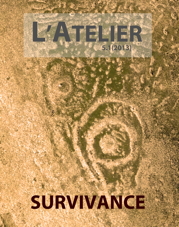« Just once a year, the dead live for one day… » : survivance dans Under the Volcano de Malcolm Lowry
Mots-clés :
Lowry, Malcolm, Under the Volcano, SurvivanceRésumé
Cet article se concentre sur le premier chapitre d’Under the Volcano qui place d’emblée le roman sous le signe de la survivance. C’est en effet grâce à Laruelle, seul survivant de la tragédie qui s’est déroulée un an plus tôt, que le lecteur pénètre dans l’univers mexicain du roman en ce Jour des morts 1938. Les lieux que traverse Laruelle sont peuplés de fantômes, le passé semblant s’affirmer avec plus de force que le présent ; c’est donc sur une atmosphère profondément mélancolique que s’ouvre le roman. Mais la survivance participe également de l’écriture d’Under the Volcano car le passé remémoré fait effraction sur la trame narrative, creusant le texte et lui conférant un fonctionnement rhizomique qui est celui-là même de la survivance. Le chapitre tout entier se présente d’ailleurs comme un jeu d’intermittences entre ombre et lumière, ceci pouvant évoquer les images fixes séparées par des blancs sur une pellicule de film, film dont on sait que l’illusion de mouvement dépend de la persistance rétinienne. Or dans sa lettre à Jonathan Cape, Lowry suggère que l’on pourrait lire le roman comme le film tourné par Laruelle, la grande roue Ferris sur laquelle se ferme ce chapitre nous projetant le film de la tragédie du Consul. Le cercle de l’éternel retour se fait donc création permanente, tout comme la survivance, comme l'écrit Georges Didi-Huberman, est tout à la fois « mort continuée » et « vie continuée ».
This article focuses on the first chapter of Under the Volcano which clearly bears the stamp ofs urvival, thus pointing to the importance of this theme in the whole novel. It is indeed through Laruelle ‒ the only one to have survived the tragedy which occurred a year earlier ‒ that the reader is introduced to the Mexican setting of the novel on the Day of the Dead 1938. The places where Laruelle wanders are peopled by ghosts, the past having far more weight than the present; therefore the atmosphere on which the novel opens is deeply melancholy. But survival also presides over the writing of Under the Volcano as the remembered past breaks onto the narrative surface of the text, delving caves which provide it with its rhizome-like structure,a structure which is also characteristic of survival. And indeed the whole chapter plays with the alternation of appearance and disappearance as it insists on flickering lights. This may well call to mind the fixed images separated by blanks on film reels, movies depending on the persistence of images on the retina to create the illusion of movement. We may here recall that Lowry, in his letter toJonathan Cape, suggests that the novel could actually be seen as the movie Laruelle planned on making, the luminous Ferris wheel at the end of the chapter thus projecting the film of the Consul’s tragedy. The circularity of eternal recurrence therefore becomes that of permanent recreation, just as survival is at once “death continued” and “life continued”.
Publiée
Numéro
Rubrique
Licence
-
L’envoi spontané d’un article à la rédaction de L’Atelier implique l’autorisation de publication et la cession des droits dans les limites établies par la loi de propriété intellectuelle.
-
L’Atelier conserve les droits de reproduction des articles publiés, quelque soit le support : internet, CD ROM, réimpression, photocopie, etc.
-
L’auteur conserve le droit de publier ultérieurement son article déjà paru dans L’Atelier avec la seule obligation de mentionner le nom de la revue comme source de la première publication.


